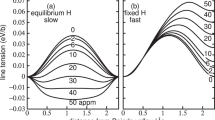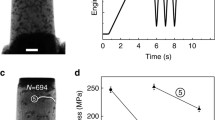Summary
The work has been suggested by the fact that in pure metals with dislocations, the point defects, such as impurity atoms, may give rise to thermally activated elastic relaxation effects. Palladium has been chosen as metal basis and hydrogen as interstitial because palladium is absorbent of hydrogen, which may be introduced with an electrolytical process and degassed with the electrolytical opposite process, without any change of dislocation density in the material. The experiments show that an electrolytic charge of hydrogen atoms of the order of 0.4.10-3 per palladium atom modify theQ −1(T) curve of the permanently strained material at low temperatures. The characteristic relaxation effects due to the dislocation motion (Bordoni peaks) disappear, while a new relaxation is introduced. A structural explanation of the relaxation is proposed that is based on an interaction mechanism between impurities and dislocations.
Riassunto
II lavoro è stato suggerito dal fatto che la presenza di impurità interstiziali nei metalli puri, deformati permanentemente, può produrre effetti di rilassamento elastico attivati termicamente. È stato scelto il palladio come métallo base e l’idrogeno come impurità poiché è possibile introduire ed estrarre facilmente questo gas dal palladio con processi elettrolitici, senza alterare apprezzabilmente la densità delle dislocazioni prodotte con la deformazione permanente. I risultati sperimentali mostrano che una carica di 0.4-l0- atomi di idrogeno per atomo di palladio, modiflca l’andamento. della curvaQ − 1(T) del coefficiente di dissipazione elastico nell’intervallo di temperature compreso fra 77 ° K e 300 °K. I caratteristici effetti di rilassamento dovuti al moto pelle dislocazioni (Bordoni peaks) presenti nel materiale deformato permanentemente, scompaiono se il materiale contiene idrogeno mentre si manifesta un nuovo effetto di rilassamento. Viene proposta una spiegazione strutturale di questo risultato, basata su un meccanismo di interazione fra le impurità e le dislocazioni.
Similar content being viewed by others
References
C. R. Cupp:Progr. Met. Phys.,4, 105 (1953)/ See also bibliography.
D. P. Smith:Hydrogen in Metals (Chicago, 1948).
F. Kruger andG. Gehm:Ann. d. Phys.,16, 174 (1933).
E. Nahring:Ann. d. Phys.,21, 303 (1934).
A. Coehn andH. Z. Baumgarten:Phys. Chem.,130, 545 (1927).
G. Chaudron, J. Benard andA. Michel:Compt. Rend.,218, 913 (1944).
G. Chaudron, J. Benard andA. Michel:Bull. Soc. Chim.,12, 336 (1945); see ref. (1).
P. G. Bordoni, M. Nuovo andL. Verdini:Suppl. Nuovo Cimento,18, 55 (1960).
P. Schiller:Phys.-Stat. Sol.,5, 391 (1964).
Author information
Authors and Affiliations
Rights and permissions
About this article
Cite this article
Fanti, F. Internal friction in hydrogen-charged palladium. Nuovo Cim 38, 728–736 (1965). https://doi.org/10.1007/BF02748593
Received:
Published:
Issue Date:
DOI: https://doi.org/10.1007/BF02748593




